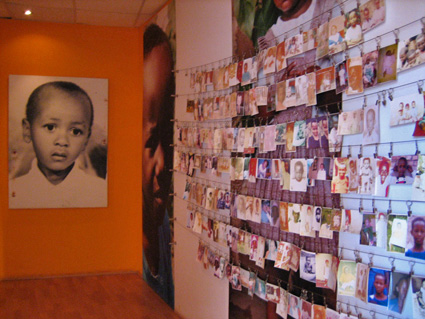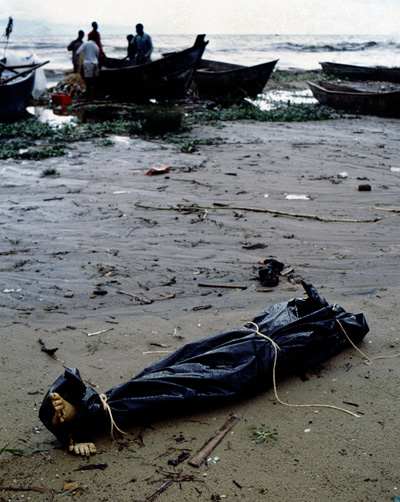Today marks the end of a week of national mourning in Rwanda to mark 15 years since the genocide which killed 800,000 people. On the 7th of April ceremonies were held in the capital Kigali, and in Nyanza, where more than 5,000 people were slaughtered. At a stadium in Kigali, thousands of candles spelt out the word “hope” in three languages.
Rwandan blogger Negrita's Chronicles asked her readers to join the nation-wide candlelight vigil for the victims through her blog:
It has been 15 years since the Genocide forever changed my home and my people.
The world stood silent as cries for help went unheeded.
Please join us in lighting a candle in memory of those whose lives were taken and in hope for a future of peace, justice, and true reconciliation.
In succesive posts, Negrita posted a video for the campaign Candles for Rwanda, and the song ‘Never Again’ written and recorded in commemoration of the Genocide. The song was composed by Rwanda's gospel singer Jean Paul Samputu in Kinyanrwanda, but its choruses are sung in different languages (English, French, Swahili, Kirundi and Kiganda) by various popular regional musicians.

Pictures of children victims of genocide at the Kigali Memorial Center (Photo by Elia Varela Serra)
Martin Leach, the head of the DFID (British Department for International Development) in Rwanda attended the ceremonies in Nyanza, which he describes in his blog:
Hundreds of people trudged up the long hill to Nyanza, many of them wearing something purple, a neckscarf, a wrap, even a purple wristband. The colour purple is the colour of mourning in Rwanda and yesterday, 7th April, was the 15th Anniversary of the Genocide. At the top of the hill I joined the large crowd at the Commemoration Ceremony. Wedged between two ambassadors, I heard heart breaking accounts from survivors of the massacre which took place on the site where we were seated, with no one to protect them against the brutal attacks of the militia.
But it was the young people who moved me most: girls dressed in purple and white reciting poems in Kinyarwandan about the need to take courage for the future in spite of the sorrow and grief, and a youth choir with ‘Never Again’ emblazoned on their T-shirts and headbands, singing with emotion about the importance of never forgetting the genocide. And it was emotional. Even the Government Ministers were shedding tears, remembering their experiences and lost loved ones. I can't imagine it – one million people killed in 100 days: as the Lady Mayor of Kigali said ‘an unspeakable evil’ had gripped the country.
Michael Abramowitz of the US Holocaust Memorial Museum was in Kigali for the ceremonies. In the blog World is Witness, Abramovitz recounts the testimony of a genocide survivor called Venuste that moved the audience with his story during the ceremony:
Venuste, who looked to be in his 50s or 60s, with a dignified bearing, proceeded to tell the hushed crowd how his family and neighbors decided to take refuge at the nearby L’Ecole Technique Officielle, thinking that might be a safe refuge because of the small contingent of Belgian United Nations soldiers stationed there. But four days later, to their great shock, the small U.N. force departed, telling those gathered on the school grounds that “gendarmes” would rescue them. The U.N. soldiers ignored their desperate pleas not to leave them at the mercy of a menacing crowd of government soldiers and armed militia that surrounded them outside the gates of the school.
After the departure of the last U.N. soldier, Venuste and some 5,000 others who were gathered on the school grounds were forced to walk a jeering gauntlet of Hutu militiamen, soldiers and civilians wielding machetes, guns and other weapons. Some of those who survived described it as a “death walk.” Venuste lost his right arm, hacked off by one of the tormentors. The walkers came to this unremarkable hill, where they were encircled by a gang of killers and set upon with grenades, machetes and clubs. Within a few hours, Venuste said, “We were lying in pools of blood.”Of the 5,000 or so who sought refuge from the U.N. near here, roughly 100 survived, according to Venuste. He lived only because he laid still under dead bodies, overlooked by the killers searching the carnage for signs of life.
Impressed by the economic development of Rwanda, Abramowitz sees no traces of the atrocities experienced 15 years ago:
As I first-time visitor to Rwanda, it’s hard not to be mystified by the mismatch between the ferocious events of just 15 years ago and apparent calm and prosperity in Rwanda, which aspires to be the hub of an economically vibrant East Africa. As we drove out of town to one of the churches where you can still see the skulls and belongings of murdered Tutsi, we passed by workers digging up ditches on the side of the road to lay down new fiber optic lines. A newcomer thinks: How can this beautiful country, routinely described by Africa hands as one of the better functioning countries on the continent, have experienced such savagery?

Ugandan fishermen pulling bodies out of Lake Victoria that had traveled hundreds of miles by river from Rwanda (Photo by Dave Blumenkrantz, used under a Creative Commons license)
Colette Braeckman [Fr], a Belgian journalist and author of several books about Central Africa, was also present at the anniversary ceremony in Kigali of which she writes:
Depuis la foule amassée devant le « jardin de la mémoire » et le monument consacré au génocide, des cris jaillissent, perturbent les discours officiels. A tout moment, des corps convulsés ou immobilisés par les syncopes sont emportés par des ambulances. Lorsque Venuste Kasirika s’empare du micro et raconte son calvaire, son récit est ponctué par les sanglots qui secouent l’auditoire.
Walking around modern-day Kigali, Braeckman makes a similar observation as Abramowitz about the disconnect with the horrible past:
Dans cette cité moderne, ambitieuse, dont les quartiers populaires ont été rasés et les habitants transplantés plus loin, au milieu de ces immeubles abritant des banques, des commerces et des bureaux, au vu de ces parterres taillés au ciseau et de ces espaces verts qui ressemblent à des jardins anglais, comment croire que, voici quinze ans, les bennes de la voirie ramassaient les cadavres à la pelle et les déversaient devant l’hôpital, comme des tas d’immondices ? Au vu de ces gens bien habillés, portant tous des chaussures de ville (les nu pieds sont interdits) comment se souvenir de ces tueurs au regard halluciné, ivres de bière, de chanvre et de haine, ceints d’amulettes, qui brandissaient fusils et longues machettes et traquaient, comme du gibier, leurs voisins tutsis débusqués dans les faux plafonds, les fossés et les fourrés de haies vives ?
Yves Zihindula [Fr], a Congolese blogger based in Goma, remembers the genocide as seen from the other side of the border:
Voici 15 ans jour pour jour, que des centaines de milliers de gens (réfugiés) se sont déversés en République démocratique du Congo. Cette date me rappelle les images abominables des femmes et enfants affaiblis par la faim dans les rues de Goma. Je me souviens avoir vu des cadavres d’homme dans le lac Kivu, jetés depuis la partie rwandaise du lac et emmener par la vague vers les bords du côté congolais. J’ai vu à l’époque des camions à benne transporter des corps humains et déposer dans des fosses communes.
Des souvenirs pas du tout bons. Ça me fait toujours bizarre de réaliser cette tragédie. Des humains s’entretuer. Quand bien même chez les animaux, ces genre des situations arrivent rarement. J’ose espérer que ça ne se répétera plus jamais et que l’Afrique entière (pourquoi pas le monde entier) en a tiré les leçons.
Not good memories at all. It still feels weird to realize this tragedy. Humans killing each other. Even between animals these kinds of situations rarely happen. I dare to hope that this is not going to happen again and that the whole Africa (and the whole world) have learnt a lesson.







9 comments
Thanks for this post, Elia – interesting to see the mix of perspectives from both old hands and first-time visitors, as well as local and regional responses.
There’s a new video (by Jane Wells of 3 Generations) on the Hub showing commemoration ceremonies from the Kigali Memorial Centre, scenes described in these posts, but that many of us will not have seen with our own eyes before:
“Never Again” Remembering Rwanda is something that has to be remembered by the world and the International Community which should make it a point that they will not make the same mistake over again and “Never Again” tolerate such a situation occurring in any part of the world at any time.
On such occurrence/incident is now taking place in a part of the country of Sri Lanka where about 250,000 civilians are said to be “trapped” in a war zone. The world/International community which says “Never Again” is AGAIN making the same mistake of watching the impending death of a large number of the civilians in Sri Lanka.
After 15 years and in the same month of April, the World, International Community, UN and the so-called powerful countries of the civilized world are again hiding behind the mask of “Sovereignty” and not taking any firm action to stop the impending mass death of civilians in Sri Lanka through the adamant action of the Sri Lankan Government not heeding o the pleas of the International Community and the UN.
The mass death that occurred in Rwanda should “Never Again” be allowed to happen in any country and that too by the so-called “legitimate and democratically elected Government” of any “sovereign” country be it Sri Lanka now or any other country in future.
The UN and the world must forget about the so-called “Sovereignty” of the Sri Lankan Government and must unilaterally intervene to STOP the MASS death of Thamil Civilians at the hands of the Sri Lankan Security forces who are using war planes, helicopters and artillery in firing at the civilian population in the war zone with the intent of “rescuing” the civilians from the war zone on humanitarian grounds. REAL IORNY. Everyone is watching and acting in the same way as they did in the case Rwanda and repenting now.
Let the World say “Never Again” and act immediately in Sri Lanka on Humanitarian grounds before it is too late so as not to regret later as in the case of Rwanda and shed crocodile tears.
“Humanitarians” please awake and act before it is late to avoid regretting later.
What a powerful post, Elia. Thank you.
~ Maya
(GVO, Israel)
…Websites you should visit
[…]I am not positive where you are getting your info, however good topic.[…]